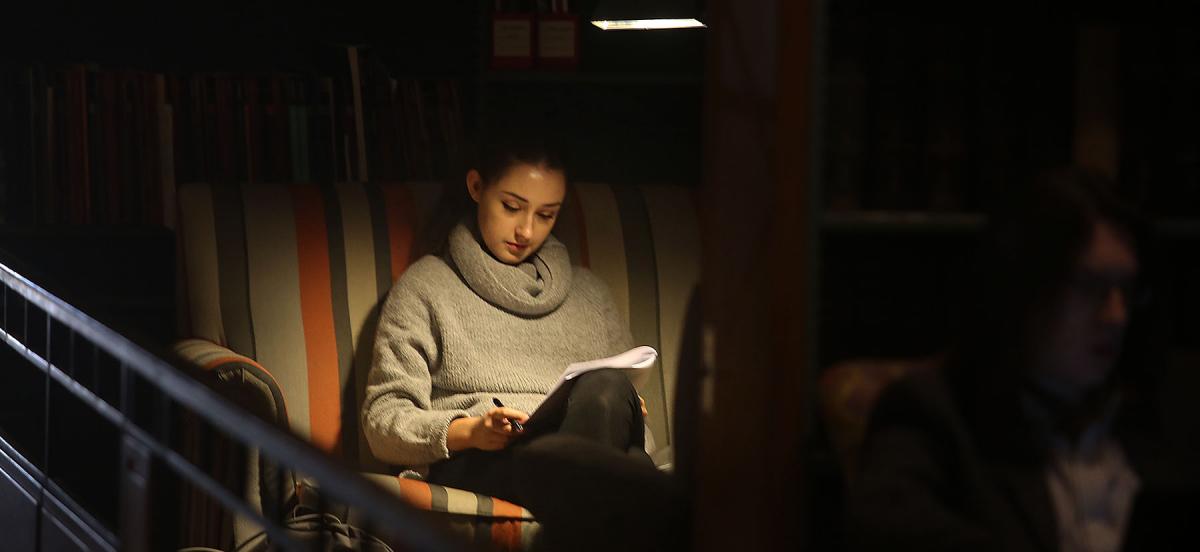Dorm Residents "Do It In The Dark" To Promote Sustainable Habits

Studying by low light. Photo by Leigh Taylor.
Details
During the annual energy-saving competition, sponsored by the Committee for Environmental Responsibility, the campus saved a whopping 4,885 kWh overall, more than twice last year's total.
For the third year in a row, Haverford students participated in the campus-wide Do It In The Dark competition, which pits residence halls against one another in an energy-saving competition. With appliances unplugged and hallway lights turned off, residents of nine dorms compared decreases in their energy use over two weeks. With a 22.9 percent decrease in kilowatt-hours, Gummere Hall proved to be the most efficient dorm during the competition, repeating last year’s victory.
The event is organized by the Committee for Environmental Responsibility (CER), is a joint student-faculty group that oversees various sustainability initiatives and encourages environmental responsibility in the practices of community members and in the College’s administrative decisions. This year’s Do It In The Dark (DIITD) was again considered successful in its goal: incorporating energy-efficient practices in students’ daily routines.
"We will only mitigate the most damaging of effects of climate change if collectively we make smart choices about the energy we use," said Jesse Lytle, College vice president, chief of staff to President Kim Benston, and chief sustainability officer. “Do it in the Dark challenges students to think about how their individual choices can add up to make a real difference. The results of DIITD speak for themselves: when Haverford students put their minds to it, they can do great things."
The competition kicked off on the evening of Oct. 30 with a CER-hosted "bring your own mug" ceremony in the Dining Center Lobby, featuring performances by the Humtones and S-Chords, two Haverford a cappella groups, and free hot chocolate and cider. At the end of the competition, on Nov. 13, prizes were awarded to residents of multiple dorms instead of the “winner-takes all” format featured in years past. The rewards this year came from the Center For Peace and Global Citizenship (CPGC) Café, which maintains a selection of fair-trade, responsibly sourced food and drink. A 10 percent reduction won a free baked good from the café, while reaching the 17 percent reduction threshold earned a choice between a baked good or a drink. Students were able to track their dorms’ progress online at the College's page on buildingdashboard.net and in the Dining Center, where the CER maintained an updated white board listing dorm reductions. For some students, the competition prompted serious habitual changes; for others, it was an easy routine.
"Do It In The Dark has not been too far removed from many of my past experiences," explained Jacob Murray ’19, a resident of Gummere. "At home, I had a habit of turning on way more lights than necessary and my parents were very conscious of making me aware of only turning on lights where and when they were needed."
For others, like Maarten Hesseling ’19 who lives in Tritton (the newest first-year dorm on campus), Do It In The Dark promoted a new type of mentality. "For me, Do It I The Dark was a reminder to be smart about water and power use… A reminder to turn my lights off when not using them, to shorten my showers, and more generally to avoid unnecessary usage and waste," he said.
DIITD has traditionally been a more popular event among first-years, which showed in the results this year as freshmen dorms Barclay and Tritton, with their respective 14.6 percent and 12.2 percent energy reductions, both surpassed the 10 percent threshold. However, Leeds Hall, inhabited entirely by upperclassmen, jumped into third place this year with an impressive 14.2 percent reduction.
Regardless of rankings, this year’s competition and its prize-rewarding system fostered an environment not of cross-dorm comparison, but of competition with oneself.
"We hope [the new system] eliminated some of the unfairness of previous competitions and encouraged dorms to reach a higher standard of energy savings instead of simply encouraging them to be marginally better than other dorms," said Alana Tartaro ’17, student chair of the CER. "Hopefully, [students] will understand exactly how much of an impact their small behaviors can make when added together."
The new setup seemed to pay off. Though this year’s competition lasted only two weeks as opposed to last year’s three, the number of kilowatt-hours saved during the competition far surpassed last year’s value, rising from 2,401 kWh to a whopping 4,885 kWh.



